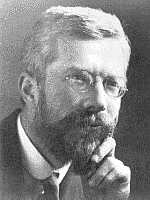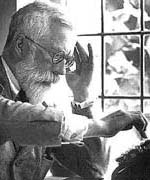Tales of Statisticians
Ronald A Fisher
17 Feb 1890 - 29 July 1962Statistically speaking, Fisher's life was lived in counterpoint with, and its tone was set in tension with, that of Karl Pearson. Both made major contributions. The personal clash between them, which Fisher kept warm in the 25 years by which he outlived Pearson, pointed to a philosophical difference which remains current in the field. Second only to the Bayesian Rift, it is the deepest fissure in statistics.
Fisher's father, a London art auctioneer, lost his fortune early, and Fisher attended Cambridge on scholarship. From the beginning, he was interested in biology, and his first lecture, given while still a student at Cambridge, was on eugenics. His work remains consequential in biology, especially evolution theory, as well as in general statistical methods. Pearson, a scientific generalist of impressive range, was mathematically weak. Fisher's brilliance in mathematics, especially in geometry, earned him prizes at Cambridge. He rarely detailed the mathematical arguments for his important findings, leaving it to others (notably Cramér) to fill them in for him later, thus (in most cases) eventually demonstrating the soundness under the brilliance.
After some years of school teaching, Fisher in 1919 was offered two positions: one at the Galton lab under Pearson, the other at the Agricultural Experiment Station at Rothamsted, the oldest such institution in England. Given Fisher's intellectual tensions with Pearson, and his previous interest in farming (he had thought at one point of taking up farming as a livelihood), he accepted the latter. From that somewhat muddy vantage point, with its testing fields and its volumes of observations, which had been mindlessly gathered over years by the previous tenants, Fisher made important discoveries about experiment design (centrally, the value of randomization), about what can be done with imperfect data, and how single factors can be separated out from a data set in which they overlap. The ultimate fruit of this was the widely used technique called Analysis of Variance, for which the key computation is Snedecor's F, labelled "F" by Snedecor (who calculated tables for it) in honor of Fisher.
Fisher's demanding handbook Statistical Methods for Research Workers appeared in 1925, and went through ten editions. Hard or no, it was the only thing of its kind, a book for doers rather than learners, and study groups formed around it in many countries, one of them including the young Wilcoxon, to try to make sense of its obvious but not fully accessible treasures. It was notable among other things for its interest in small samples, a focus which Fisher shared, and on which he indeed collaborated, with Gosset.
In 1933, with the retirement of Karl Pearson as Galton Professor at University College, there ensued an unimaginably foolish arrangement, with Fisher replacing Pearson in the sense of running the Galton Lab on the second floor, while Egon Pearson, Karl's apostate son, succeeded to another aspect of his father's work on the first floor. F N David has said of this period:
Fisher's summa on experiment design was The Design of Experiments, which appeared in 1935. (Comment from someone). Among these were . . . the acidly titled Exact Test (a jibe at Person, whose X-squared function Fisher here meant to replace, for small data sets). Serology, became important in WW2, and provided the first basis for Cavalli-Sforza, much later continued with the new DNA tool. Asperity, separation from wife. Oxford, again appalling conditions. Loss of son George: "tough it out"
At this moment and at many others, it can indeed be said that Fisher showed toughness under adversity, an adversity not always of his own making.
Fisher was finally admitted to the Royal Society in 19XX. The comment following the first paper he there presented directly apologizes for the previous lack of official recognition for the importance of his work:
Fisher retired from Cambridge in 1957, but stayed on for two years until a successor was found. He spent his last three years at the University of Adelaide in Australia, where his papers are still preserved. The Indian connection.
Fisher's shabby treatment of the work of Jerzy Neyman and Karl's son Egon Pearson on hypothesis testing (which he called "a pile of junk") cannot be excused, but it can be explained as a replica of his own dismissal by Pearson senior. Thus do pathetic humans learn behavior from the worst models available to them. The parallel is complete: Fisher by this period had in fact begun to be eclipsed mathematically by the coming generation represented by Neyman/Pearson, and they in turn by the work of Cramér, who not only glossed the gaps in Fisher's missing proofs, but bridged the gap between these English developments and the parallel axiomatic line which had been taken, in the same period, by Kolmogorov and the other Russian Probabilists.
In any field worth contributing to in the first place, eclipse is inevitable. One may at least strive to bear with composure one's few moments in the light.
Statistics is Copyright © 2001- by E Bruce Brooks
4 Sept 2004 / Contact The Project / Exit to Statistics Page

